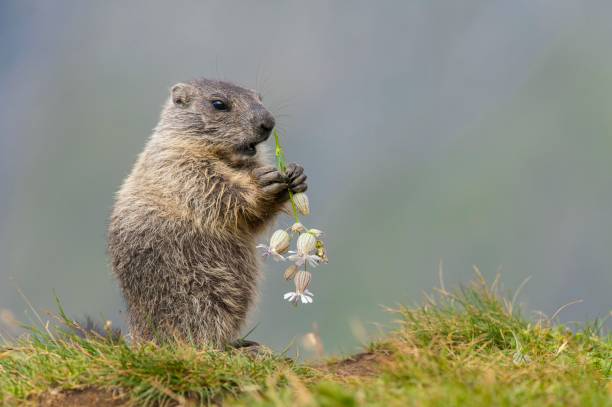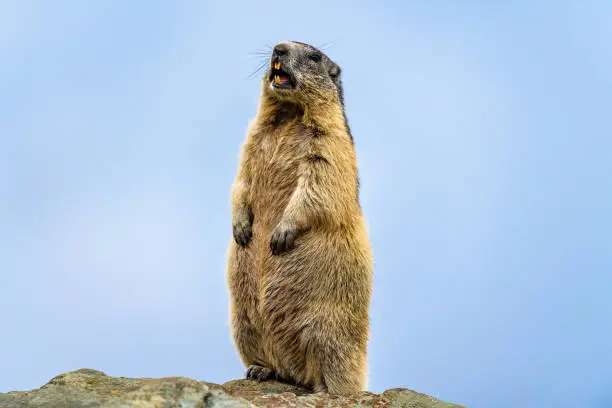Table of Contents
Scientific Classification
| Kingdom | Animalia |
| Phylum | Chordata |
| Class | Mammalia |
| Order | Rodentia |
| Family | Sciuridae |
| Genus | Marmota |
| Species | Marmota marmota. |
| Scientific Name | Marmota marmota |
Description
The Alpine Marmot is a robust rodent belonging to the squirrel family. Its sturdy body is covered in thick fur, ranging from brown to gray, which helps it blend seamlessly into the mountainous terrain. These mammals typically weigh between 4 to 8 kilograms and measure 45 to 58 cm in length, with an additional 13 to 20 cm of bushy tail.
The marmot’s compact build is well-suited to its cold alpine habitat. It has rounded ears, strong limbs, and powerful claws that enable it to dig extensive burrows. Its continuously growing teeth allow the marmot to efficiently chew through the tough vegetation found in its mountainous home.
Distribution
Alpine Marmots are native to the high-altitude regions of central and southern Europe. Their primary range includes:
The Alps (Austria, Switzerland, France, Italy, Germany, Slovenia)
The Carpathian Mountains
The Pyrenees
Parts of the Apennines
They also learned about areas like the Jura Mountains and the Massif Central in France. This helps control plants and supports biodiversity.
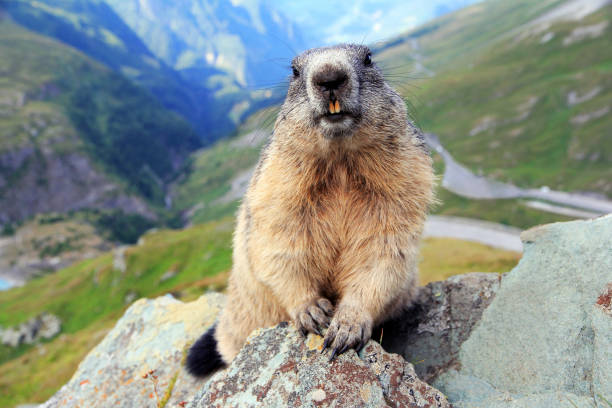
Habitat
These habitats offer:
Plenty of plants for nourishment.
Soft soil for building burrows.
Rocky hideouts to escape from predators.
Marmots create extensive burrow systems that serve as protection from harsh weather and predators. In winter, they go deep into their burrows, sealing themselves in to hibernate.
Diet
As herbivores, Alpine Marmots feed primarily on:
Grasses and herbs (e.g., dandelions, clover, alfalfa)
Flowers and berries
Roots and shoots
Occasionally, insects and small invertebrates (as a minor part of their diet)
They spend summer building up fat reserves. This helps them survive the long winter hibernation.
Behavior
Alpine Marmots are very social. They live in family groups with a dominant breeding pair in charge. Their daily activities include:
Foraging in groups while keeping an eye out for predators.
Grooming each other to reinforce social bonds.
Sunning on rocks to regulate body temperature.
Burrowing to create complex underground shelters.
Alarm calling using sharp whistles when detecting threats.
They are diurnal, meaning they are active during the day and retreat to their burrows at night.
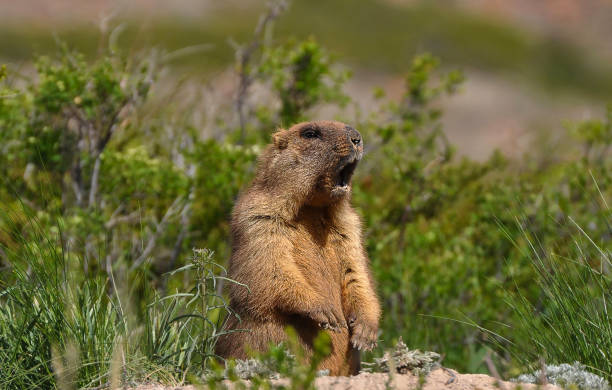
Lifespan
Alpine Marmots typically have a lifespan of 12 to 15 years in the wild. In captivity, they can live as long as 18 years. Their survival is mainly influenced by their ability to evade predators and withstand the severe winter conditions.
Reproduction and Lifecycle
Mating takes place in the spring (April to May), shortly after the animals emerge from hibernation. The breeding cycle includes the following stages:
Gestation: Lasts approximately 30 to 35 days.
Litter Size: Typically consists of 2 to 4 pups, although as many as 7 can be born.
Nursing Period: The young remain in the burrow for about 5 to 6 weeks, depending on food availability and weather conditions.
Parental Care: Both parents, along with older siblings, help in raising the pups.
Maturity: Young marmots stay with their family for 2 to 3 years before leaving to establish their own burrows.
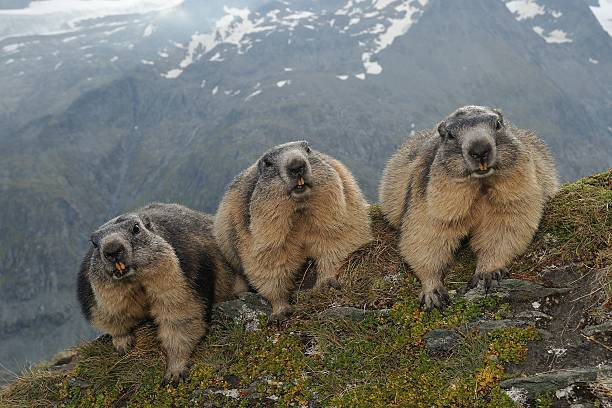
Predators
Despite their size and social vigilance, Alpine Marmots are preyed upon by:
Golden Eagles (primary aerial predator)
Red Foxes (ambushing young marmots)
Eurasian Lynxes (occasional predators)
Wolves (in some regions)
Humans (historically hunted for fur and meat)
Their keen eyesight and alarm calls make for a strong defense. These calls warn others to retreat into burrows.
Adaptations
Alpine Marmots have developed several adaptations to thrive in their extreme environment:
Hibernation – Surviving cold winters by lowering body temperature and metabolic rate.
Fat Storage – Building fat reserves in summer for sustenance during hibernation.
Thick Fur – Providing insulation against freezing temperatures.
Burrowing Instincts – Creating underground refuges that maintain stable temperatures.
Social Structure – Living in groups for protection and efficient resource use.
Conservation Status
- The Alpine Marmot is currently listed as Least Concern by the IUCN. Nonetheless, there are specific threats that impact their populations, such as:
- Habitat Destruction – Resulting from the growth of ski resorts, road construction, and agricultural expansion.
- Climate Change – Influencing the availability of food and altering hibernation patterns.
- Hunting – While not as frequently hunted today, these animals were historically pursued for their fur and meat.
- Conservation Efforts
- Protected Areas: Numerous Alpine regions have set up conservation zones to safeguard wildlife.
- Legal Protections: Hunting bans in specific areas have contributed to stabilizing animal populations.
- Reintroduction Programs: In various regions, successful reintroduction of Alpine Marmots has played a key role in enhancing biodiversity.
Conclusion
The Alpine Marmot is a fascinating and resilient rodent, perfectly adapted to life in high-altitude environments. Its social behavior, hibernation patterns, and digging abilities enable it to survive in the challenging regions of Europe. While its population is currently stable, ongoing conservation efforts are essential to ensure this iconic mountain species continues to thrive in its natural habitat.
